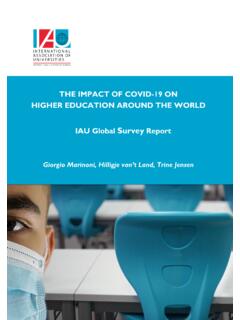Transcription of 2016-2019 Wellness Strategic Plan - Health and Wellness
1 2016-2019 . Wellness Strategic Plan INDEX. Executive Strategic . Goal . Goal Goal 18. Goal 22. Social-Ecological Framework and Life-Course Perspective 24. One University Health and Wellness Council Culture and Environment of 25. Health and Wellness Strategic Planning 26. 2. EXECUTIVE SUMMARY. Vision: The healthiest university and community in the world. Mission: We exist to optimize the highest levels of Wellness for faculty, staff and students across the university and global community. Definition: Wellness is the optimal state of living well, regardless of an individual's spectrum of Health and encompasses physical, intellectual, mental, emotion- al, social, occupational, financial, environmental and spiritual well-being. Rationale: A growing body of research evidence indicates that employees and students who have higher levels of Wellness : (a) are more engaged, productive, and satisfied, (b) perform at higher levels, including academics, (c) miss less work and school, and (d) are at a lower risk for the development of chronic disease, which accounts for more than 75% of healthcare spending.
2 Currently, according to our 2015 Personalized Health Assessment capturing data from 28,199 faculty and staff, 64% of our employees are overweight (32%) or obese (32%); have either pre-hypertension ( ) or hypertension ( ); have a HgbA1c level equal to or higher than , have elevated cholesterol (200 and above), 4% are current smokers, only 28% engage in the recommended 150 minutes of moderate physical activity per week, and report elevated levels of anxiety. In 2015, 14% of our employees fell into the healthy category, 51% were stable, 28% were at risk, 6% were struggling, and 1%. were in crisis. Eighty-eight percent of faculty and staff think that it is important for OSU to promote Health and Wellness for faculty, staff and students. Sixty-sev- en percent of faculty and staff believe that OSU has a culture and environment that promotes Health and Wellness . Return on Investment (ROI): Findings from studies, including systematic reviews, indicate that the ROI for every dollar invested in Wellness is approximately $4.
3 Dollars, and includes fewer healthcare claims. Ohio State invests approximately million dollars in Wellness every year, which includes the Health Plan, Your Plan for Health , the Office of the Chief Wellness Officer, and Student Life. Ohio State's ROI was calculated for the following programs: Wellness Education and Programming, Biometric Health Screening, Health Coaching and Care Coordination. The Truven Health and Productivity Management Return on Investment Model was utilized: Cumulative medical savings, with program $12,733,871. Cumulative productivity savings, with program $15,424,829. Return on Investment (ROI), medical care $ ROI, workplace productivity $ ROI, medical care + workplace productivity $ 3. 2016-2019 Goals: 1. Enrich the Wellness component of OSU's culture and environment that supports the nine dimensions of Wellness for faculty, staff, and students 2. Engage in evidence-based practices and continuous quality improvement to facilitate sustained healthy lifestyle behaviors to ultimately reduce the burden of chronic conditions while providing measurable outcomes and demonstrating value.
4 3. Communicate simply, moving towards a goal of having an effective voice for faculty, staff and student Wellness . 4. Promote local, state-wide, and national/international Wellness through the sharing of best practices to impact change and population Health outcomes. Structure: At OSU, we have developed a unique comprehensive and integrated structure for Wellness . Strategic leadership for Health and Wellness is provid- ed by the One University Health and Wellness Council, which is comprised of key leaders across the University who have responsibility for various aspects of Health and Wellness for faculty, staff and students, along with representation from faculty, staff, students, and University communications (see Appendix A). The Council is chaired by OSU's Chief Wellness Officer, Senior Vice President for Talent, Culture and Human Resources, and Senior Vice President for Student Life. There are currently five sub-councils under the One University Health & Wellness Council, including an alignment sub-council whose purpose is to ensure alignment of Strategic initiatives across the University and OSU Health System.
5 Framework: The Socioecological Framework and life course perspective is guiding individual, social and family network, organizational and policy interven- tions with an emphasis on the seven strategies from the National Prevention Strategy (See Appendix B). Strategic Plan Tactics: Our 2016-2019 Wellness Strategic plan is based on the best evidence from rigorous research that indicates a multicomponent interven- tion strategy is necessary for best Health and Wellness outcomes. Wellness initiatives must not only be focused on assisting individuals with healthy lifestyle behavior change through Wellness programming and benefit design, but also must include building a Wellness culture and environment that make healthy choices the easy choices for individuals to make ( , the social norm here at OSU). Studies indicate that support and role modeling from leaders along with grass roots involvement from our more than 500 faculty and staff Wellness innovators are critical in facilitating and supporting a Wellness culture and environ- ment.
6 Findings from studies also indicate that the institution of Health and Wellness policies ( , tobacco free; flexible work schedule) is important in promoting healthy lifestyle behaviors. Therefore, our Strategic plan includes implementation of interventions directed at the individual, social and family network, work- place and policy levels (see Appendix B). Our goals and priorities are driven by our own population data. Measureable Outcomes: Our current Health and Wellness scorecard includes three categories of metrics (Appendix C): 1. Culture and environment of Health and Wellness , which is measured with the OSU Wellness culture survey, the Limeade well-being assessment, and data from the HealthLead, Health Enhancement Research Organization, and CDC Worksite Score Card. 2. Population Health outcomes, including prevalence data to show the burden of illness in the population, incidence data to show the rate of change in the 4. burden of illness in the population over time, self-reported Health behavior data (National Prevention Strategy) to highlight actionable interventions, mental Health data (PHQ-2 and GAD-2 screening score distributions) to emphasize the impact of mental Health on physical Health , and biometric data to assess the impact of behavioral Health interventions on risk factors for chronic disease, and self-reported general Health status and engagement in programs offered (engagement in programming must be incentivized more than just completion of PHA; completion of a PHA must be combined with comprehensive Health promotion programming and the building of a Wellness culture and environment), 3.
7 Fiscal Health , including per member per year (PMPY) costs of Health insurance plans for faculty, staff and students, incentive and programmatic spend, an- nual costs of absenteeism, presenteeism, and disability, and excess costs associated with obesity, hypertension, prehypertension, diabetes, pre-diabetes, depression and smoking. We expect to maintain and/or improve leading Health indicators ( , obesity, hypertension, and management of diabetes) by 1%. each year with our intervention tactics. Ohio State as a National and State-wide Leader in Wellness : In addition to the tremendous benefits of Wellness for our own faculty, staff and students, we have shared best practices to enhance Wellness at the state and national levels and positioned Ohio State as a leader in this area. We hosted the first national and state-wide summits on Building Healthy Academic Communities and founded the National Consortium for Building Healthy Academic Communities with 15. other Universities for which OSU serves as its administrative home.
8 We received the first university-wide accreditation in Health and Wellness from HealthLead and have established key partnerships with community and national organizations as well as federal agencies. In addition, we are conducting collaborative cutting-edge research on Wellness that will not only benefit our University family, but others throughout the state and nation. Student Wellness has won the following national awards: HealthLead - Silver Level, Healthiest Campus accreditation, NASPA Gold Excellence Award in Health Counseling and Wellness , and Top 12 Campus for Active Minds Healthy Campus. 5. Strategic PLAN. Goal #1: Enrich the Wellness component of culture and environment that supports the nine dimensions of Wellness for faculty, staff, and students Objective (SMART) Actions Responsibility Performance Indicators/Outcomes Resources Target Date Status Specific, Measurable, Who will do it? How will achievement(s) be measured? Required (frequency Achievable, Realistic, to be Time evaluated).
9 Monitor the culture Incorporate the Wellness Culture & Environment YP4H/CWO/One Data on the scale will be analyzed and Statistical Yearly, end of Annually, and environment Scale by Melnyk and Amaya into the PHA University Health presented to the One University Health & support October every of the university on & Wellness Wellness Council for analysis November a yearly basis to Council assess progress. Leaders and Present data on faculty/staff/student Wellness CWO All identified leaders and managers will IT/administrative Yearly Yearly in managers to leaders and managers with evidence-based be debriefed on the data through a yearly support November/. across the University strategies to build Wellness cultures and presentation and attend/view the program Dec will provide a environments supportive Wellness culture and Present data to senior management council and CWO Attendance at yearly state of Health and CWO budget Yearly Yearly in environment in their president's cabinet, council of deans, faculty Wellness and number of presentations November/.
10 Units/colleges. council, staff advisory council through the annual made to various groups Dec state of Health and Wellness in Buckeye Nation, other presentations to leader groups, and webinars Offer the Leader Health Athlete Program to CWO/CON/ 50 leaders and supervisors will attend the CWO/CON/ At least 2 to 3 July 2017. VPs, Deans, Department Chairs, Managers and BW Team program each year Buckeye programs per July 2018. Supervisors Wellness Health year delivered for athlete trainers leaders Provide an incentive challenge to leaders and CWO % participation in challenge; college/unit CWO budget Yearly Yearly in July supervisors to enhance college/unit culture and scores on Wellness culture scale environment Leaders and supervisors are recognized for CWO Number of leaders who are recognized CWO/Buckeye Launch October Ongoing providing a supportive Wellness culture with awards Wellness 2016. Ongoing November/Dec 6. Increase the number Provide new faculty/staff Wellness innovator CWO/Director Number of faculty/staff and student CWO/Director Yearly Oct, March, of faculty/staff and program orientation 3x per year of Health innovators added every year Health June student innovators promotion (HP) promotion/.





